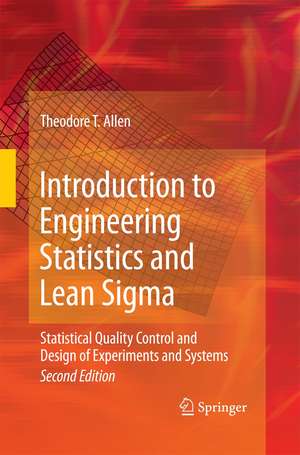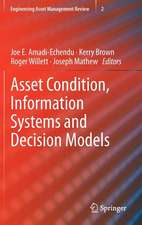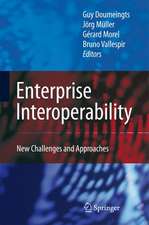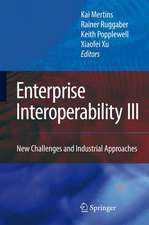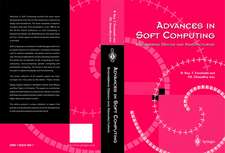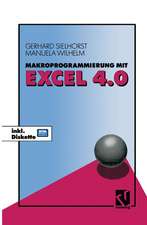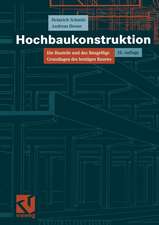Introduction to Engineering Statistics and Lean Sigma: Statistical Quality Control and Design of Experiments and Systems
Autor Theodore T. Allenen Limba Engleză Paperback – 19 oct 2014
As well as providing detailed definitions and case studies of all six sigma methods,Introduction to Engineering Statistics and Lean Sigmaforms one of few sources on the relationship between operations research techniques and lean sigma. Readers will be given the information necessary to determine which sigma methods to apply in which situation, and to predict why and when a particular method may not be effective. Methods covered include:
• control charts and advanced control charts,
• failure mode and effects analysis,
• Taguchi methods,
• gauge R&R, and
• genetic algorithms.
The second edition also greatly expands the discussion of Design For Six Sigma (DFSS), which is critical for many organizations that seek to deliver desirable products that work first time. It incorporates recently emerging formulations of DFSS from industry leaders and offers more introductory material on the design of experiments, and on two level and full factorial experiments, to help improve student intuition-building and retention.
The emphasis on lean production, combined with recent methods relating to Design for Six Sigma (DFSS), makesIntroduction to Engineering Statistics and Lean Sigmaa practical, up-to-date resource for advanced students, educators, and practitioners.
Preț: 474.43 lei
Preț vechi: 585.72 lei
-19% Nou
Puncte Express: 712
Preț estimativ în valută:
90.79€ • 94.44$ • 74.96£
90.79€ • 94.44$ • 74.96£
Carte tipărită la comandă
Livrare economică 08-14 aprilie
Preluare comenzi: 021 569.72.76
Specificații
ISBN-13: 9781447157533
ISBN-10: 1447157532
Pagini: 596
Dimensiuni: 155 x 235 x 31 mm
Greutate: 0.83 kg
Ediția:2nd ed. 2010
Editura: SPRINGER LONDON
Colecția Springer
Locul publicării:London, United Kingdom
ISBN-10: 1447157532
Pagini: 596
Dimensiuni: 155 x 235 x 31 mm
Greutate: 0.83 kg
Ediția:2nd ed. 2010
Editura: SPRINGER LONDON
Colecția Springer
Locul publicării:London, United Kingdom
Public țintă
GraduateDescriere
The
Toyota
Production
System,
or
lean
production,
has
long
been
regarded
as
critical
to
business
success
in
many
industries.
Over
the
last
ten
years,
instruction
in
six
sigma
has
been
increasingly
linked
with
learning
about
the
elements
of
lean
production.Introduction
to
Engineering
Statistics
and
Lean
Sigmabuilds
on
the
success
of
its
first
edition
(Introduction
to
Engineering
Statistics
and
Six
Sigma)
to
reflect
the
growing
importance
of
the
"lean
sigma"
hybrid.
As well as providing detailed definitions and case studies of all six sigma methods,Introduction to Engineering Statistics and Lean Sigmaforms one of few sources on the relationship between operations research techniques and lean sigma. Readers will be given the information necessary to determine which sigma methods to apply in which situation, and to predict why and when a particular method may not be effective. Methods covered include:
• control charts and advanced control charts,
• failure mode and effects analysis,
• Taguchi methods,
• gauge R&R, and
• genetic algorithms.
The second edition also greatly expands the discussion of Design For Six Sigma (DFSS), which is critical for many organizations that seek to deliver desirable products which work first time. It incorporates recently emerging formulations of DFSS from industry leaders and offers more introductory material on the design of experiments, and on two level and full factorial experiments, to help improve student intuition-building and retention.
The emphasis on lean production, combined with recent methods relating to Design for Six Sigma (DFSS), makesIntroduction to Engineering Statistics and Lean Sigmaa practical, up-to-date resource for advanced students, educators, and practitioners.
As well as providing detailed definitions and case studies of all six sigma methods,Introduction to Engineering Statistics and Lean Sigmaforms one of few sources on the relationship between operations research techniques and lean sigma. Readers will be given the information necessary to determine which sigma methods to apply in which situation, and to predict why and when a particular method may not be effective. Methods covered include:
• control charts and advanced control charts,
• failure mode and effects analysis,
• Taguchi methods,
• gauge R&R, and
• genetic algorithms.
The second edition also greatly expands the discussion of Design For Six Sigma (DFSS), which is critical for many organizations that seek to deliver desirable products which work first time. It incorporates recently emerging formulations of DFSS from industry leaders and offers more introductory material on the design of experiments, and on two level and full factorial experiments, to help improve student intuition-building and retention.
The emphasis on lean production, combined with recent methods relating to Design for Six Sigma (DFSS), makesIntroduction to Engineering Statistics and Lean Sigmaa practical, up-to-date resource for advanced students, educators, and practitioners.
Cuprins
Statistical
Quality
Control.-
Statistical
Quality
Control
and
Six
Sigma.-
Define
Phase
and
Strategy.-
Measure
Phase
and
Statistical
Charting.-
Analyze
Phase.-
Improve
or
Design
Phase.-
Control
or
Verify
Phase.-
Advanced
SQC
Methods.-
SQC
Case
Studies.-
SQC
Theory.-
Design
of
Experiments
(DOE)
and
Regression.-
DOE:
The
Jewel
of
Quality
Engineering.-
DOE:
Screening
Using
Fractional
Factorials.-
DOE:
Response
Surface
Methods.-
DOE:
Robust
Design.-
Regression.-
Advanced
Regression
and
Alternatives.-
DOE
and
Regression
Case
Studies.-
DOE
and
Regression
Theory.-
Optimization
and
Strategy.-
Optimization
and
Strategy.-
Tolerance
Design.-
Design
for
Six
Sigma.-
Lean
Sigma
Project
Design.
Recenzii
From
the
reviews
of
the
first
edition:
"A basic introduction to six sigma concepts, this book provides added depth to some statistical concepts. Theodore Allen uses a wide variety of example types to show the value of tools ranging from administrating medication in a hospital to welding with robotics. … One of the main points that Allen makes throughout the book is that, you do not need to understand all the theory behind the statistics to benefit from these tools.
I recommend this book."
(Roger Sauter, Boeing, inTechnometrics, Vol. 49 (2), 2007)
"A basic introduction to six sigma concepts, this book provides added depth to some statistical concepts. Theodore Allen uses a wide variety of example types to show the value of tools ranging from administrating medication in a hospital to welding with robotics. … One of the main points that Allen makes throughout the book is that, you do not need to understand all the theory behind the statistics to benefit from these tools.
I recommend this book."
(Roger Sauter, Boeing, inTechnometrics, Vol. 49 (2), 2007)
Notă biografică
Dr
Theodore
Allen
is
an
associate
professor
in
Industrial
and
Systems
Engineering
at
The
Ohio
State
University
and
a
co-founder
of
the
software
company,
Sagata
Ltd.
He
is
a
senior
member
of
the
American
Society
of
Quality
and
an
associate
editor
ofThe
Journal
of
Manufacturing
Systems(Elsevier).
Textul de pe ultima copertă
Lean
production,
has
long
been
regarded
as
critical
to
business
success
in
many
industries.
Over
the
last
ten
years,
instruction
in
six
sigma
has
been
increasingly
linked
with
learning
about
the
elements
of
lean
production.Introduction
to
Engineering
Statistics
and
Lean
Sigmabuilds
on
the
success
of
its
first
edition
(Introduction
to
Engineering
Statistics
and
Six
Sigma)
to
reflect
the
growing
importance
of
the
"lean
sigma"
hybrid.
As well as providing detailed definitions and case studies of all six sigma methods,Introduction to Engineering Statistics and Lean Sigmaforms one of few sources on the relationship between operations research techniques and lean sigma. Readers will be given the information necessary to determine which sigma methods to apply in which situation, and to predict why and when a particular method may not be effective. Methods covered include:
• control charts and advanced control charts,
• failure mode and effects analysis,
• Taguchi methods,
• gauge R&R, and
• genetic algorithms.
The second edition also greatly expands the discussion of Design For Six Sigma (DFSS), which is critical for many organizations that seek to deliver desirable products that work first time. It incorporates recently emerging formulations of DFSS from industry leaders and offers more introductory material on the design of experiments, and on two level and full factorial experiments, to help improve student intuition-building and retention.
The emphasis on lean production, combined with recent methods relating to Design for Six Sigma (DFSS), makesIntroduction to Engineering Statistics and Lean Sigmaa practical, up-to-date resource for advanced students, educators, and practitioners.
As well as providing detailed definitions and case studies of all six sigma methods,Introduction to Engineering Statistics and Lean Sigmaforms one of few sources on the relationship between operations research techniques and lean sigma. Readers will be given the information necessary to determine which sigma methods to apply in which situation, and to predict why and when a particular method may not be effective. Methods covered include:
• control charts and advanced control charts,
• failure mode and effects analysis,
• Taguchi methods,
• gauge R&R, and
• genetic algorithms.
The second edition also greatly expands the discussion of Design For Six Sigma (DFSS), which is critical for many organizations that seek to deliver desirable products that work first time. It incorporates recently emerging formulations of DFSS from industry leaders and offers more introductory material on the design of experiments, and on two level and full factorial experiments, to help improve student intuition-building and retention.
The emphasis on lean production, combined with recent methods relating to Design for Six Sigma (DFSS), makesIntroduction to Engineering Statistics and Lean Sigmaa practical, up-to-date resource for advanced students, educators, and practitioners.
Caracteristici
Second
edition
of
a
successful
book
expands
on
two
major
topics
of
increasing
relevance
to
organizations:
lean
production
and
design
for
six
sigma
Enables readers to identify which six sigma methods are most suitable for particular scenarios
Enables readers to identify which six sigma methods are most suitable for particular scenarios
